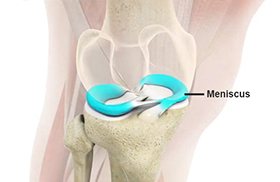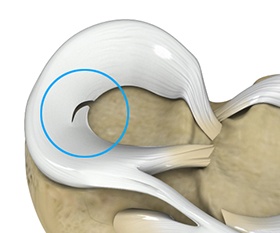Meniscal Tears
General Information
Introduction

Every joint in the body is lined by extremely smooth tissue called “articular cartilage.” The articular cartilage of the knee coats the end of the femur (thigh bone), the top surface of the tibia (shin bone) and the back surface of the patella (kneecap). In addition to articular cartilage, the knee joint also has meniscal cartilages which are two specialised pieces of tissue which act as shock absorbers.
Each knee has two menisci, one on the inner side (medial meniscus) and one on the outer side (lateral meniscus). The menisci sit between the tibia and the femur bones. The meniscus has a complex role in the function of the knee joint. Its main role seems to be protection of the articular cartilage from wearing out. It is the shock absorbing capacity of the meniscus that protects against arthritis in the future. The meniscii also assist with stability of the knee joint as well as helping disperse fluid around the knee joint effectively.
What is a meniscal tear?
The meniscal cartilages are at risk of tearing due to their constant exposure to repetitive loading as we walk, run or perform other activities. A meniscal tear usually develops when the knee is partially bent under load, especially with twisting motions such as pivoting during sports, squatting and changing direction. Meniscal tears can also occur in combination with tears of ligaments around the knee (eg an ACL tear). It is also possible to injure a meniscus without any trauma as the meniscus stiffens and weakens with age.
Symptoms & Diagnosis
What symptoms can you experience with a meniscal tear?
You might experience a crack or a popping sensation when you initially tear your meniscus. However on some occasions, you may not have had a precipitating event or injury. The pain from a meniscal tear is often localised to the inner or outer part of the knee joint, and less so at the front of the joint. Symptoms include pain with bending and twisting on your knee, and sometimes pain at night. Often people with meniscal tears complain of stiffness within the joint, recurrent swelling of the knee joint (“water on the knee”), or a sensation of catching or locking of the knee.
Some meniscal tears are very large. Depending on their pattern, a fragment of the damaged meniscus may loosen partially and drift into the knee joint between the tibia and femur bone. When this occurs the fragment may cause a block to movement and the knee becomes locked, limiting your ability to straighten or bend your knee.
Diagnosis
Your surgeon will take a thorough history and examination to assess for all the symptoms and signs of a meniscal tear. As part of your workup, x-rays will be ordered to exclude other conditions in the knee such as arthritis or pieces of floating, loose bone within the joint. Additionally you may undergo a test called an MRI (magnetic resonance imaging scan) which looks more specifically at the soft tissues within the knee, especially the meniscus and the articular cartilage.
What else apart from a meniscus tear could be causing my pain?
Meniscal tears are extremely common and often are the cause of people’s symptoms as detailed above. Other things, however, can mimic these symptoms. These include loose pieces of bone (“loose body”) floating around the knee joint, a loose flap of articular cartilage that has become unstable on either the femoral or the tibial articular surface, patellofemoral pain syndrome or a plica (soft tissue fold within the knee).
Treatment
The initial treatment for a meniscal tear should follow the basic RICE formula: Rest, Ice, Compression and Elevation, often combined with a non-steroidal anti-inflammatory medication. This is very helpful in settling the acute symptoms of a meniscal tear. If a lot of swelling is present, a tubular stocking on the knee may assist in reducing this. It is important also to maintain muscle strength around the knee joint and joint motion as the joint can lose its function quite quickly in the acute setting.
Surgical treatment

If your meniscal tear causes pain and mechanical symptoms such as clicking, locking or catching, you may require arthroscopic knee surgery. This is performed as a day surgery “key-hole” procedure (see knee arthroscopy). In most circumstances only the damaged portion of the meniscus is excised.
In some circumstances depending on the configuration of the meniscus tear, the tear can be repaired. Your surgeon will discuss this option with you prior to surgery.
Prognosis
Not all meniscal tears require surgery. As a general rule the younger you are, the more likely you are to require surgery to repair your meniscus tear. As the meniscus has a vital role in protecting the articular cartilage within the knee, it is critical that large tears of the meniscus especially in young people are investigated for the possibility of an arthroscopic repair.
The risk of arthritis in the future is increased in patients with a meniscal tear who have had a significant portion taken out, especially that of the lateral meniscus which is on the outer part of the knee. Your surgeon will counsel you regarding your individual risk of progressing to knee arthritis, and what measures are available to you to slow this progression.
 healthin
healthin